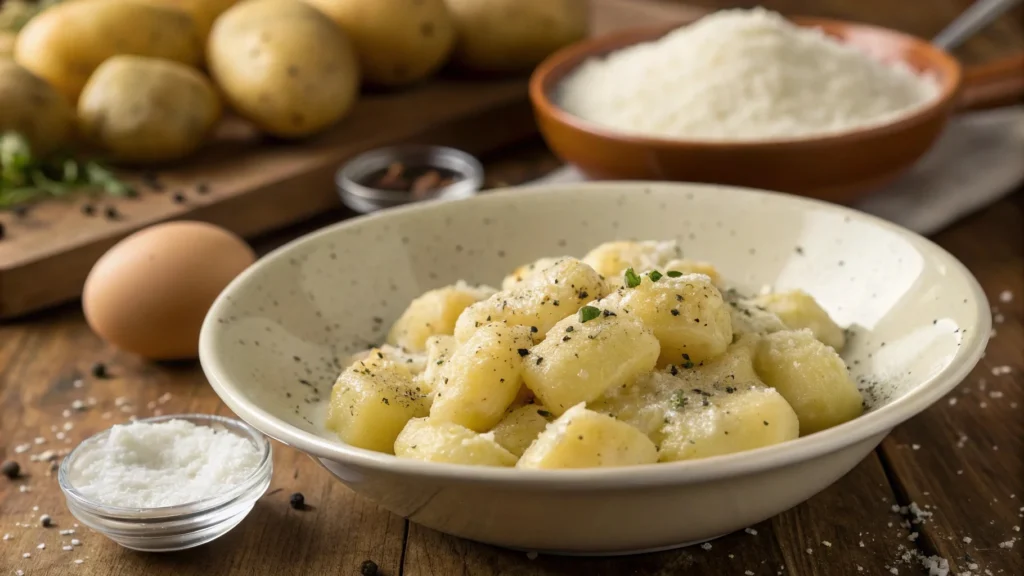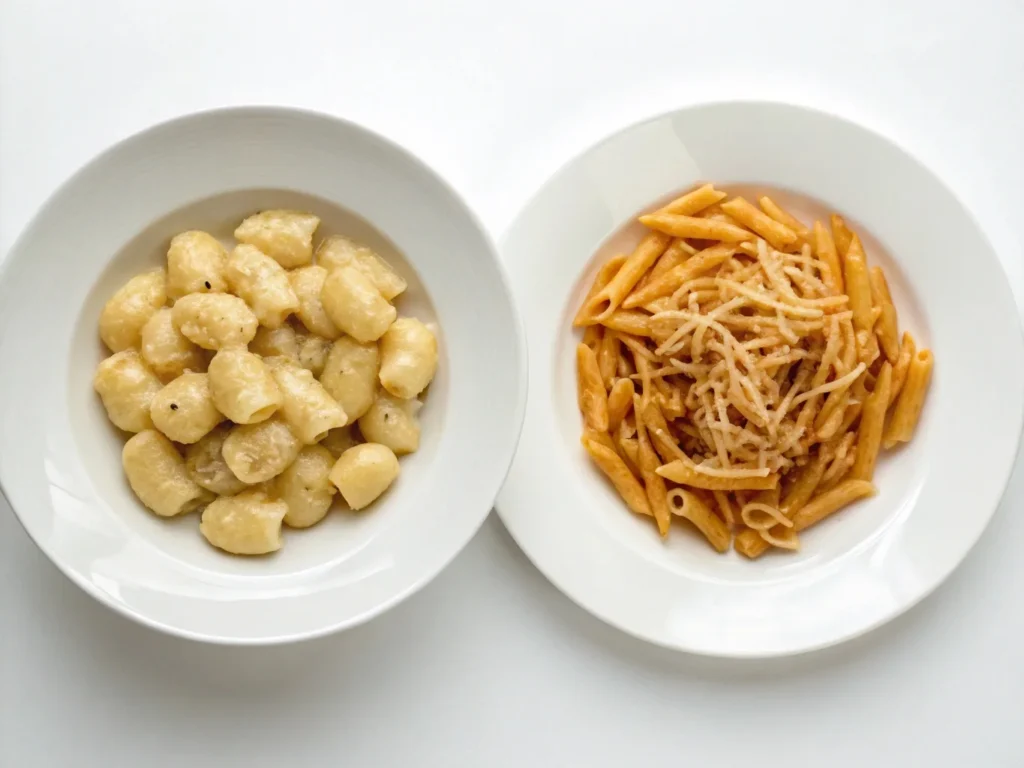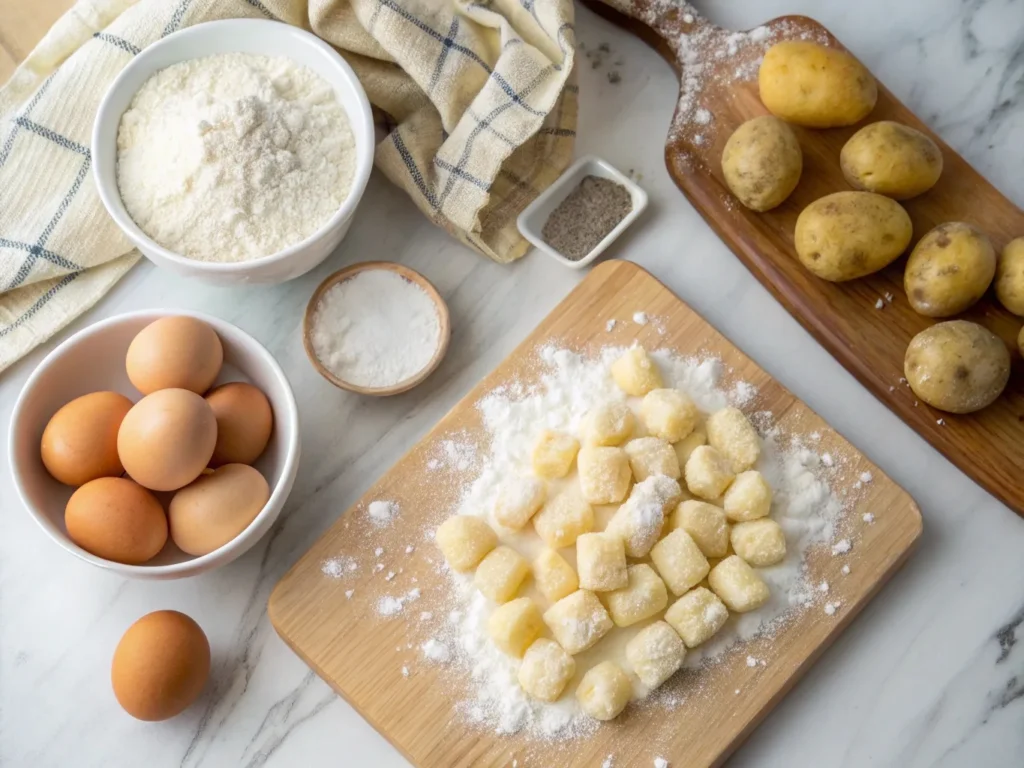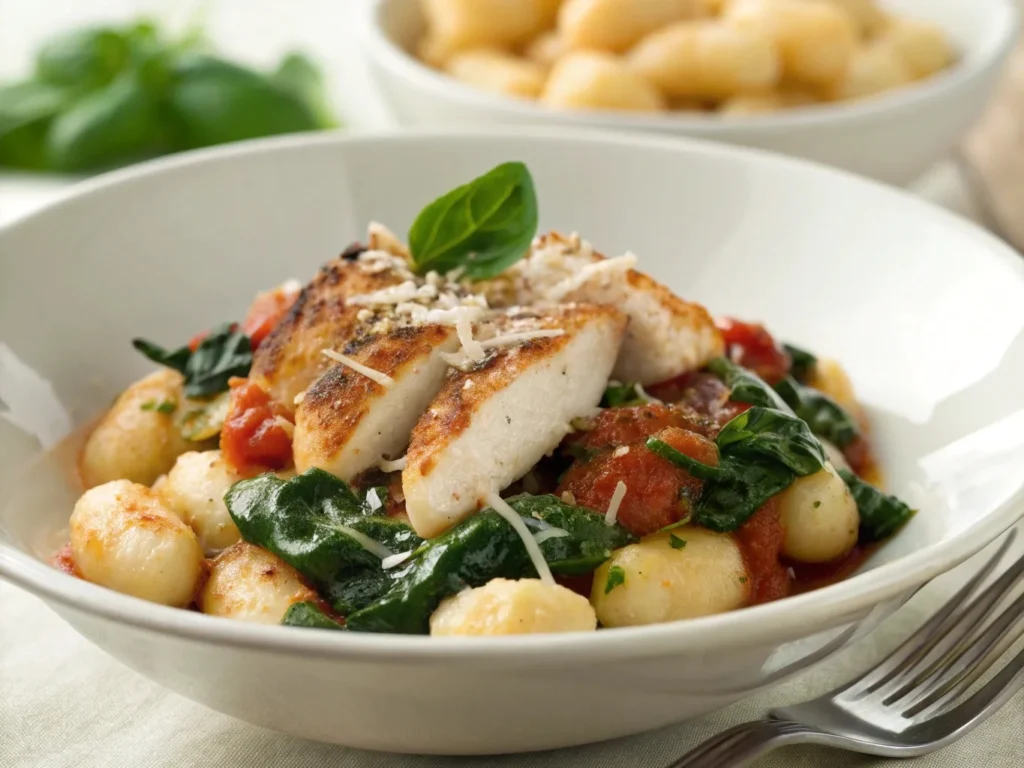Gnocchi nutrition at a glance: one cup of these pillowy dumplings packs around 250 calories, 50 g carbs, and surprising protein you can balance with smart sides.
Every time I catch the aroma of freshly cooked gnocchi, I’m taken back to my grandmother’s kitchen in Naples. Those soft, pillowy potato dumplings were more than just a meal. They were a connection to my heritage, a culinary embrace that sparked my lifelong fascination with gnocchi nutrition.
Gnocchi is more than just a delicious Italian dish. Knowing its nutritional profile helps you make better dietary choices. Whether you’re into fitness, love food, or are curious about balanced eating, learning about gnocchi calories and nutritional content can change how you see this classic comfort food.
From its humble potato origins to its place on modern dining tables, gnocchi offers a unique nutritional landscape. This exploration will uncover the secrets behind these delectable dumplings. It will help you appreciate them beyond their irresistible taste.

Key Takeaways
- Gnocchi nutrition varies based on ingredients and preparation methods
- A typical serving contains approximately 250 calories
- Gnocchi offers moderate protein and carbohydrate content
- Portion control is key for maintaining dietary balance
- Different gnocchi variants provide unique nutritional benefits
What is Gnocchi? A Look at Its Nutrition and Origins
Gnocchi is a tasty Italian pasta that brings comfort and tradition to your table. These small, soft dumplings are loved by many for their unique texture and rich history. Let’s start exploring the traditional potato gnocchi nutrition profile by learning about its origins and characteristics.
A Brief History of Gnocchi
Gnocchi have deep roots in Italian cooking. *Originating in Northern Italy*, they’ve been a favorite in Italian homes for centuries. The name “gnocchi” comes from the Italian word *”nocchio”*, meaning a knot in wood, which fits their shape. Peasants made these dishes with simple ingredients like potatoes, flour, and eggs.
Curious about the history of gnocchi? Learn more in our guide: Is Gnocchi a Potato or a Pasta?
Types of Gnocchi
Traditional potato gnocchi nutrition profile changes with different regional recipes. While potato-based gnocchi is most common, there are exciting variations:
- Potato Gnocchi: Classic version made with potatoes, flour, and eggs
- Ricotta Gnocchi: Lighter version using ricotta cheese instead of potatoes
- Pumpkin Gnocchi: Seasonal variant with a distinctive orange color
- Cauliflower Gnocchi: Modern, low-carb alternative gaining popularity
Each type has its own nutritional benefits and flavors. This makes gnocchi a versatile dish that can please many tastes. Whether you stick to the classics or like to try new things, gnocchi is a great choice for creative cooking.
Understanding Gnocchi Nutrition: Calories and Macronutrients
Exploring gnocchi nutrition shows us a lot about this Italian pasta favorite. Knowing what’s in it helps us make better food choices when we eat it.
Caloric Content Breakdown
A two-ounce serving of gnocchi has about 89 calories. The number of calories can change based on what’s in it and how it’s made. Homemade gnocchi nutrition facts mean you can control the nutrition more than store-bought ones.
Macronutrient Analysis
Gnocchi has a special mix of nutrients that makes it different from regular pasta. Let’s look at what’s in it:
| Nutrient | Amount per 2 oz Serving | Percentage of Daily Value |
|---|---|---|
| Carbohydrates | 19 grams | 7% |
| Fiber | 0.9 grams | 3% |
| Protein | 2.5 grams | 5% |
| Fat | 1.5 grams | 2% |
Remember, gnocchi nutrition can vary. Ricotta gnocchi has more protein than potato-based ones. Watching how much you eat helps you keep gnocchi part of a healthy diet.
Health Benefits of Gnocchi
Learning about gnocchi’s health benefits can guide your food choices. Gnocchi isn’t a superfood, but it has some good points when eaten wisely. It’s part of a healthy diet.
Energy-Providing Carbohydrates
Gnocchi is packed with carbs, giving you about 30-35 grams per cup. These carbs are key for your body’s energy. A cup has around 135 calories, fitting well into your daily energy needs.
Trace Minerals and Nutritional Profile
Gnocchi also has minerals like magnesium, potassium, and phosphorus. You get about 36.8 mg of magnesium per serving. This helps your muscles and nerves work right.
| Mineral | Amount per Serving |
|---|---|
| Magnesium | 36.8 mg |
| Calcium | 18.9 mg |
| Vitamin C | 24.8 mg |
Even though gnocchi isn’t super rich in nutrients, adding veggies and lean proteins makes it better. The secret is to eat it in moderation and plan your meals well.
Gnocchi vs. Pasta: A Nutritional Comparison
Exploring gnocchi nutrition is key to making smart food choices. Both gnocchi and traditional pasta are Italian favorites. But they have different nutritional profiles and compositions.
Gnocchi carbs are unique compared to pasta made from wheat. Gnocchi comes from potatoes, making them a nutritional standout. This impacts the healthiness of your meal.

Nutritional Comparison
Let’s look at the main differences between gnocchi and pasta:
| Nutrient (2 oz serving) | Gnocchi | Traditional Pasta |
|---|---|---|
| Carbohydrates | 19 grams | 43 grams |
| Protein | 2.5 grams | 7.5 grams |
| Fiber | 0.9 grams | 2 grams |
| Gluten Content | Low | High |
Which Option is Healthier?
Your choice depends on your dietary needs. Gnocchi has fewer carbs, making it great for those watching their carb intake. Pasta, on the other hand, has more protein, which is better for those needing more protein.
Both can fit into a healthy diet if eaten in moderation. Think about your nutritional needs, portion sizes, and the rest of your meal when choosing between gnocchi and pasta.
Gluten-Free and Vegan Gnocchi: Nutritional Considerations
Discovering gluten-free gnocchi can change the game for those with gluten sensitivities or celiac disease. These options offer tasty, wheat-free meals without losing flavor or texture.
Exploring Gluten-Free Ingredients
Gluten-free gnocchi mix different ingredients for a great pasta taste. Potato and rice flour are common bases. DeLallo Gluten-Free Mini Gnocchi shows how tasty gluten-free can be, with over 85% potato and rice flour.
Nutritional Composition
Knowing what’s in gluten-free gnocchi is key for those watching their health. Different ingredients change the nutritional makeup and value.
| Ingredient Type | Protein (%) | Carbohydrates (%) | Preparation Time |
|---|---|---|---|
| Traditional Wheat Gnocchi | 7-9 | 70-75 | 4-5 minutes |
| Gluten-Free Gnocchi | 4-6 | 75-80 | 2-3 minutes |
Alternative Gluten-Free Options
New gluten-free gnocchi use cauliflower, chickpeas, corn, and rice. These options have different nutrients and fit many diets, keeping the gnocchi feel.
When picking gluten-free gnocchi, check for gluten-free seals and make sure they’re made in gluten-free places. This ensures safety and quality.
Gnocchi and Weight Management
Managing your weight doesn’t mean giving up on tasty foods like gnocchi. Knowing how many calories are in gnocchi and controlling your portions can help. A typical serving of gnocchi has about 200 calories. This makes it a good choice for those watching their calorie intake.
Calorie Awareness
The number of calories in gnocchi can change based on how it’s made and what’s in it. A 2-ounce serving usually has around 89 calories. This is pretty low compared to other pasta types. Here’s a comparison to help you make better choices:
| Food Item | Calories (per 100g) | Carbohydrates | Protein |
|---|---|---|---|
| Potato Gnocchi | 135 | 17g | 2.5g |
| Spaghetti Noodles | 158 | 31g | 6g |
Portion Control Tips
To manage your weight, it’s important to control how much gnocchi you eat. Aim for smaller portions and mix gnocchi with veggies or lean proteins for a balanced meal. Here are some tips:
- Use a food scale to measure precise portions
- Fill half your plate with vegetables
- Choose lighter sauce options
- Practice mindful eating
By knowing how many calories are in gnocchi and controlling your portions, you can enjoy it while working on your weight management goals.

Cooking Methods and Their Impact on Gnocchi Nutrition
When looking at homemade gnocchi nutrition facts, it’s key to understand cooking methods. Your cooking technique can greatly change the nutritional value of these tasty potato dumplings.
How Boiling, Baking, or Frying Affects Nutritional Value
Boiling and baking are the main ways to cook gnocchi. Boiling is the traditional method, which keeps most of the gnocchi’s nutrients. Studies show boiling in salted water can lower FODMAPs by removing some elements.
Baking is another method that changes gnocchi’s texture and nutrition. It can cut down on fats and make a crispy outside that many enjoy.
Choosing Healthy Sauces and Toppings for Gnocchi
The sauces and additives you pick greatly affect your gnocchi’s nutrition. Cream-based sauces add a lot of calories, but tomato or veggie sauces offer more nutrients.
Here are some nutritional facts to keep in mind when making homemade gnocchi:
- A typical gnocchi serving has about 135 calories
- It has around 2.5 grams of protein per 100 grams
- Carbohydrates are near 17 grams per serving
Your cooking method can significantly affect gnocchi’s nutritional value. Choose lighter cooking methods and pick sauces wisely to boost health benefits.
For a creative twist, try using an outside-in stuffed gnocchi sauce to enhance the flavors and textures of your dish.
Gnocchi in a Balanced Diet
Adding gnocchi to your meals needs careful planning. It’s tasty but must be balanced. With about 220 calories and 50 grams of carbs per serving, it’s important to think about it.
Smart Meal Integration Strategies
To get the most health benefits from gnocchi, pair it with lean proteins and veggies. It has only 5 grams of protein, so adding chicken, fish, or tofu is a good idea. *Portion control* is essential for keeping your diet balanced.
Creating Nutritional Balance
Here are some tips for making gnocchi part of a healthy meal:
- Pair gnocchi with spinach or kale
- Add grilled salmon or tofu for protein
- Include a side salad for more fiber
- Use herbs and spices for flavor without extra calories
Mindful Consumption Approach
Gnocchi is high in carbs but can be part of a balanced diet. Enjoy it as an occasional treat, not every day. *Moderation* is key to keeping your diet balanced.
Your diet’s variety is more important than any single food. Gnocchi can be healthy if eaten thoughtfully with other nutrient-rich foods.
Vegan and Vegetarian Options
Exploring vegan gnocchi nutrition opens up a world of delicious plant-based possibilities. Traditional gnocchi recipes often contain eggs. But modern culinary techniques have transformed this classic dish into a versatile vegan-friendly meal.
Meatless Gnocchi Sauces
Your vegan gnocchi journey can be incredibly flavorful with creative sauce options. Consider a creamy cashew sauce that provides rich texture and nutrition. A typical vegan gnocchi sauce might include:
| Ingredient | Amount | Nutritional Benefit |
|---|---|---|
| Cashew Cream | ½ cup | Protein & Healthy Fats |
| Vegetable Broth | 1 cup | Low-Calorie Flavor |
| Sundried Tomatoes | ⅓ cup | Antioxidants |
| Fresh Basil | ¼ cup | Vitamin K |
Plant-Based Ingredients
Creating vegan gnocchi nutrition involves smart ingredient substitutions. Chickpeas can replace eggs, providing protein and binding properties. Nutritional yeast adds a cheesy flavor while boosting B-vitamins.
Your vegan gnocchi can be both nutritious and satisfying. By incorporating diverse plant-based ingredients, you’ll craft a meal that supports your dietary choices without compromising on taste or nutritional value.
Common Myths About Gnocchi
Exploring gnocchi nutrition can be tricky due to many myths. People often get confused about gnocchi carbs and their place in a healthy diet. This confusion makes it hard to enjoy this tasty Italian dish.
Debunking Carbohydrate Myths
Gnocchi nutrition myths often center around carbs. Contrary to popular belief, not all carbs are the same. Gnocchi carbs give us energy and can be part of a balanced diet if eaten wisely. Each 2-ounce serving has about 19 grams of carbs, with only 0.9 grams from fiber.
Nutrition experts say complex carbs like gnocchi’s offer more than just energy. They help keep us going and support our body’s needs. The trick is knowing how much to eat and pairing it with healthy foods.
Misconceptions About Serving Sizes
Many think gnocchi is too heavy. But, the right serving size makes a big difference. A typical portion is about the size of a wine cork, helping keep calorie intake in check.
Adding gnocchi to your meals doesn’t mean giving up on healthy eating. You can enjoy it by balancing it with veggies, lean proteins, and being careful about how you prepare it. Knowing about gnocchi nutrition helps you make better food choices.
Gnocchi Recipes for Every Diet
Discovering delicious and nutritious homemade gnocchi can change your meal planning. Whether you’re looking for quick weeknight dinners or health-conscious options, gnocchi is versatile for different diets.
Making gnocchi at home lets you control what goes into it. You can try out various recipes that fit your taste while keeping your diet balanced.
Healthy Gnocchi Strategies
The secret to healthy gnocchi is choosing the right ingredients and cooking methods. Opt for whole wheat or potato-based gnocchi for a nutritious base.
| Recipe Type | Calories/Serving | Prep Time |
|---|---|---|
| Vegetable Roasted Gnocchi | 803 kcal | 15 minutes |
| Lentil Gnocchi Bowl | 450 kcal | 10 minutes |
| Mediterranean Gnocchi | 550 kcal | 20 minutes |
Quick and Easy Gnocchi Dishes
Busy cooks can make simple gnocchi recipes in under 40 minutes. Roasting gnocchi with veggies like broccoli and bell peppers makes a meal full of nutrients. Pro tip: Use olive oil sparingly and experiment with herbs for added taste without extra calories.
Understanding homemade gnocchi nutrition facts helps you make meals that are both tasty and healthy. Just remember to keep your portions in check and mix up your ingredients for the best nutrition.
FAQs
1. How healthy are gnocchi?
Gnocchi can be a healthy meal option when consumed in moderation and paired with nutrient-rich ingredients. Since traditional gnocchi are made from potatoes, they provide energy-boosting carbohydrates, along with some fiber, potassium, and vitamin C. However, they are lower in protein and fiber compared to whole wheat pasta. Choosing homemade gnocchi or vegetable-based variations can enhance their nutritional value.
2. Is gnocchi better for you than pasta?
It depends on your dietary goals. Gnocchi generally contains fewer calories and carbohydrates than traditional pasta but is also lower in protein and fiber. If you’re looking for a lower-carb alternative, gnocchi may be a better choice. However, whole wheat or legume-based pasta options tend to be higher in fiber and protein, making them more filling. The health benefits of either depend on portion size, preparation method, and accompanying ingredients.
3. What is the nutritional value of cooked gnocchi?
The nutritional content of cooked gnocchi varies depending on the ingredients and preparation method. On average, a 100g (3.5 oz) serving of cooked potato gnocchi contains:
- Calories: ~130-140 kcal
- Carbohydrates: 28-30g
- Protein: 2-3g
- Fat: 0.5-1.5g
- Fiber: 1-2g
- Potassium: ~250mg
Ricotta or whole wheat gnocchi may have slightly different nutritional profiles, offering more protein or fiber.
4. How many calories are in 10 gnocchi?
The calorie count for 10 pieces of gnocchi depends on their size and ingredients. On average:
- 10 small gnocchi (~50g): ~70-80 calories
- 10 medium-sized gnocchi (~80g): ~110-120 calories
- 10 large gnocchi (~100g): ~130-140 calories
The total calories can vary based on whether they are boiled, pan-fried in butter, or served with a rich sauce.
5. Can I eat gnocchi and lose weight?
Yes, you can enjoy gnocchi while losing weight, as long as you practice portion control and choose healthier toppings. Here are some tips:
- Stick to a serving size of ½ cup to 1 cup to manage calorie intake.
- Pair gnocchi with high-protein foods like grilled chicken, fish, or tofu.
- Opt for lighter sauces, such as tomato-based sauces, rather than creamy ones.
- Add fiber-rich vegetables like spinach, zucchini, or bell peppers to make the meal more satisfying.
Weight loss is about overall calorie intake and expenditure, so balancing gnocchi with other nutritious foods can keep it part of a healthy diet.
6. Are there any low-carb alternatives to traditional gnocchi?
Yes! If you’re looking for low-carb gnocchi alternatives, consider:
- Cauliflower gnocchi – Made from cauliflower, this option is lower in carbs and calories while still providing a soft texture.
- Almond flour gnocchi – A grain-free, keto-friendly alternative with more protein and healthy fats.
- Chickpea or lentil gnocchi – Higher in protein and fiber compared to traditional potato gnocchi.
These variations can help maintain a lower-carb diet while still enjoying the comforting texture of gnocchi.
Conclusion: Enjoying Gnocchi Mindfully
Learning about gnocchi nutrition helps you add this tasty Italian dish to your meals. You’ve seen how gnocchi can be part of a healthy diet if eaten wisely. Pairing them with foods rich in nutrients and watching your portions is key.
Enjoy gnocchi in moderation and try different types. Sweet potato or whole wheat gnocchi offer more health benefits. Use cooking methods that add flavor without extra calories, like roasting or adding fresh veggies and lean proteins.
Enjoying gnocchi is about more than just eating. It’s about choosing quality ingredients, controlling how much you eat, and balancing your meals. Food should bring joy and connect us to our culture.

Tips for Healthy Eating
Opt for gnocchi made from whole ingredients and keep your portions in check. Pair them with foods high in nutrients. Your creativity in the kitchen can turn gnocchi into a nutritious and fulfilling meal.
Final Thoughts on Gnocchi Nutrition
See gnocchi as a food that can be part of a healthy diet. With careful preparation and smart choices, you can enjoy every bite while staying healthy.
For another comforting gnocchi dish, try this Slow Cooker Tuscan Chicken Meatballs with Gnocchi—a rich, hearty meal perfect for a cozy dinner.
